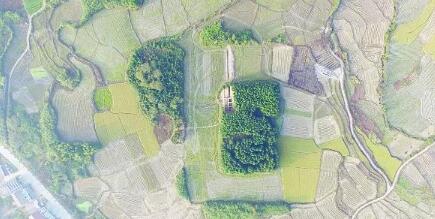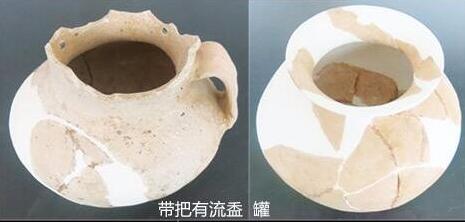Moat-surrounded settlement of Late Neolithic Age Discovered in Guodishan Site, Jiangxi Province
Jiangxi Provincial Institute of Archeology and Cultural Relics together with other institutes formed a joint archaeological team conducted the survey, exploration and excavation to the moat-surrounded settlement of Guodishan, located in the upstream of Fuhe River from July to October, 2017.

Aerial photo of moat-surrounded settlement of Guodishan
This site was composed with four parts, which were platform, wall, ditch and ditch dam, covering 42000 square meters. The excavated area was located in the northwest corner of the platform, north part of the moat and west part of the moat dam, 360 square meters in total. Features include wall base, post holes and ash pits, etc. The unearthed artifacts were stone tools and pottery, while stone wares were adz, axe and arrowhead, etc; potteries were jar, Ding-tripod, grain container (Dou), food container (Gui), water container (He), other pieces, and spindle whorls.
The culture accumulation was rather thick about 2 meters, which could be divided into four layers. According to the comparison of the unearthed items with the around site, the age could be divided into three period.

Stratum on the west of T0302
The Late Neolithic Age was mainly represented by the plate-shaped Ding-tripod, tongue-shaped Ding-tripod leg from the third and forth cultural layer, which broke the wall. The unearthed wares were common in Fanchengdui--Shixia Culture, which was belonged to the Late Neolithic Age.
Xia to Early Shang Dynasties was represented by the proto-porcelain, basin-shaped ware, flat bottom Gui vessel and He vessel with handle from ash-pit H7, which was equivalent to Late Erlitou to Early Erligang Cultures of the Central plains of China, and dated to the Late Xia to Early Shang dynasty.
Shang to Zhou Dynasties was represented by the flat Ding-tripod and jar with folded rim from Cultural Layer 1 and 2, while thunder, cord, rhomboid patterns were common in the Sites of Shang and Zhou Dynasties in Jiangxi province, and the age should be Shang and Zhou Dynasties as well.

Orthographic projection of the wall
The Dissection and Age Analysis of Wall, Ditch and Ditch Dam
Wall
The wall was located outside the platform, and the accumulation of the wall was about 3.6 m, which could be divided into 17 layers, the 1 to 16 layers was presented as slope accumulation, the Layer 17 was the base for the wall. The building method was obvious artificial. Judging from the overlapping relation and the remains of the wall, the building age should be Late Neolithic Age.
Ditch
The width of the east ditch was unclear, while the south ditch’s width was 40m, the west one was about 38 to 43 m. Based on the dissertation of the north ditch, it presented as pot shape, shallow in the sides and deep in the middle, the deepest part was about 3 m, and the accumulation could be divided into 14 layers. According to the unearthed items, Layer 7 to 9 should be Xia to Early Shang Dynasty, Layer 10 to 14 should be the age of Late Neolithic.

Unearthed pottery
Ditch Dam
The east trench dam was ruined due to the farming of the ages, while the rest was remained. From the dissection of the west trench dam, the building method and accumulation condition were similar to the ones of the wall, combining with the items unearthed from the accumulation, its establishment age should be the same with the wall and trench, which was Late Neolithic Age.
Value and Significance
Through the investigation and exploration centered with Guodishan moat-surrounded Settlements, 9 sites were discovered around it, making up a settlement cluster from Late Neolithic Age to Shang and Zhou Dynasties; Through the scientific excavation of the wall, ditch and dam, the basic elements were figured out; based on the analysis and comparison of the typical layers and unearthed items, the time frame of Late Neolithic Age , Xia to Early Shang Dynasties, as well as Shang and Zhou Dynasties could be structured out.
The archeology excavation of Guodishan Site provided precious materials for the Pre-Qin Period’s chronology, and making clear about the development of FanChengDui Culture (Translator: Lang Langtian)

